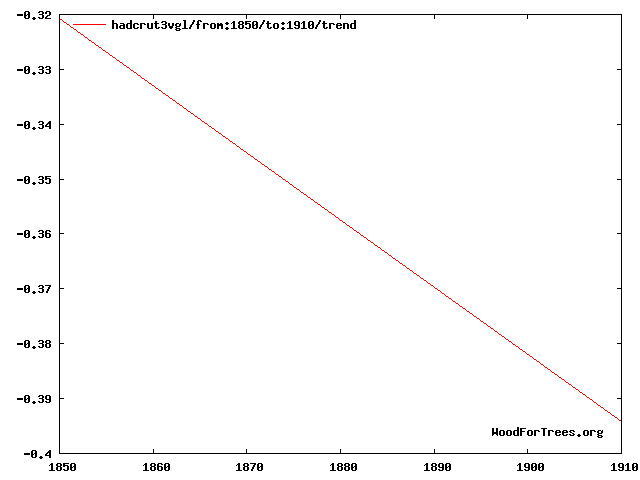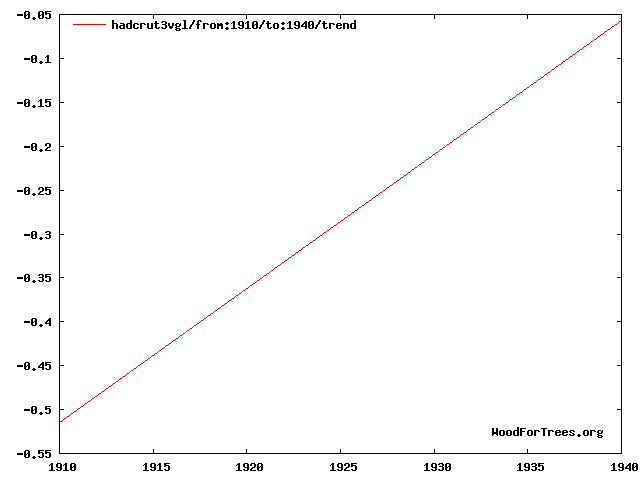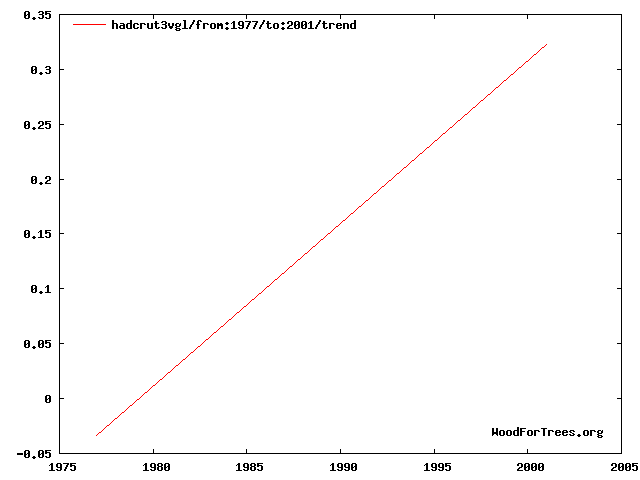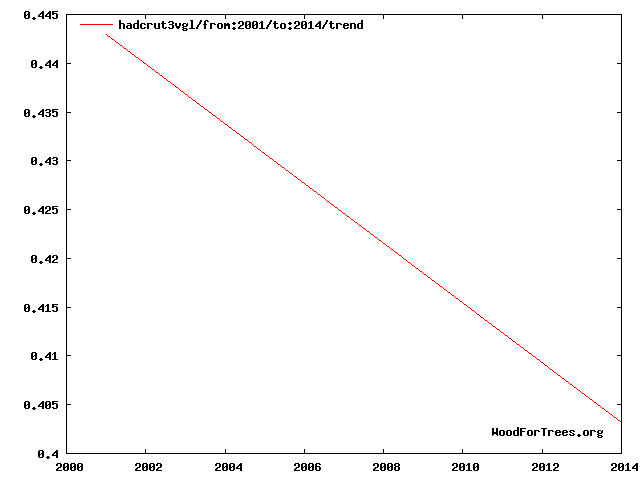By Kenneth Richard
The HadCRUT global temperature dataset that the IPCC references contains instrumental records that date back to the year 1850. Precise CO2 data (measured in tenths of parts per million) from thousands of years ago can be found in Antarctic ice cores, with direct measurements (Mauna Loa) available since the 1950s. In comparing the two records, it can be concluded that during the last 165 years, rapidly increasing CO2 concentrations only correlate with rapidly increasing global temperatures for one 25-year period (1977-2001). Put another way, for 85% of the last 165 years there has been little to no correlation between CO2 concentration changes and temperature changes.
Maximum CO2 warming occurs within 10 years after emission
Before illustrating the lack of trend correlation between CO2 and temperature during the last 165 years, it needs to be pointed out that scientists have determined that on average it takes about 10 years for the maximum warming effect from CO2 emission to be realized. In other words, CO2 emissions from the 1950s predominantly had the most pronounced effect on temperature trends by the 1960s. It could also be said that we are now experiencing the height of the warming effects of the CO2 emissions from the early 2000s. The timing of the CO2-to-temperature effect was determined by Ricke and Caldeira (2014) in their Environmental Research Letters paper entitled “Maximum warming occurs about one decade after a carbon dioxide emission”.
It is known that carbon dioxide emissions cause the Earth to warm, but no previous study has focused on examining how long it takes to reach maximum warming following a particular CO2 emission. Using conjoined results of carbon-cycle and physical-climate model intercomparison projects, we find the median time between an emission and maximum warming is 10.1 years.
Selecting decadal-sale warming and cooling phases
Having established that correlational fluctuations between CO2 concentrations and global temperature should be detectable on a decadal scale (presuming that Ricke and Caldeira [2014] are correct), the CO2 and temperature record for the last 165 years can be considered — rooted in the anthropogenic global warming (AGW) assumption that temperature fluctuations should occur in direct response to CO2 concentration changes.
The IPCC routinely selects starting and ending points from the instrumental record to establish warming and cooling phases in their trend analysis. For example, the years 1998-2012 from IPCC AR5 (2013) are selectively used to analyze the recent “hiatus” in global warming, and the years 1910 to 1940 are selected in AR4 (2007) to denote the early 20th century warming (ETCW). In that same vein, the decadal-scale periods selectively considered for this analysis are:
- 1850 – 1910
- 1910 – 1940
- 1940 – 1977
- 1977 – 2001
- 2001 – 2014
1. 1850 – 1910: -0.1°C Cooling with +15 ppm CO2
According to NASA*, between 1850 and 1910, CO2 concentrations rose from 285 ppm to 300 ppm. During this same 60-year period, global temperatures cooled by almost -0.1°C despite the +15 ppm increase in CO2 concentration. The temperature trends are illustrated below with woodfortrees interactive graphs.
2. 1910 – 1940: +0.45°C Warming with +11 ppm CO2
Between 1910 and 1940, CO2 concentrations rose from 300 ppm to 311 ppm, or by +11 ppm. Interestingly, anthropogenic CO2 emissions did not rise, but remained flat at 1 gigatons of carbon (GtC) per year during this period. Even so, in the 30 years between 1910 and 1940, global temperatures warmed by +0.45°C, or +0.15°C per decade.
Chart: www.woodfortrees.org/plot/1910/to:1940/trend
3. 1940 – 1977: -0.1°C Cooling with +23 ppm CO2
Between 1940 and 1977, CO2 concentrations rose from 311 ppm to 334 ppm, or +23 ppm. Anthropogenic CO2 emissions dramatically rose from about 1 GtC per year in 1940 to about 5 GtC per year by the mid-1970s. During these 35+ years of rapidly rising atmospheric CO2 concentrations and anthropogenic CO2 emissions, global temperatures nonetheless cooled by almost -0.1°C.
Chart: www.woodfortrees.org/trend
4. 1977 – 2001: +0.35°C Warming with +37 ppm CO2
The first and only period in the last 165 years that there was actually a correlation between rapidly rising anthropogenic CO2 emissions and rapidly rising temperature was between the years 1977 and 2001. CO2 concentrations rose from 334 ppm to 371 ppm, or +37 ppm during this period. Temperatures rose by +0.35°C, or +0.15°C per decade — a similar warming rate when compared to the 1910 to 1940 trend.
Chart: www.woodfortrees.org/plot/trend
5. 2001 – 2014: -0.04°C Cooling with +27 ppm CO2
Finally, between 2001 and 2014, CO2 concentrations rose from 371 ppm to 398 ppm, or by +27 ppm. During this same period, temperatures remained flat or even slightly cooled by a few hundredths of a degree, which meant that a substantial portion of the latest IPCC report (AR5, 2013) necessarily was devoted to explaining why the 21st century global warming “hiatus” had occurred.
Several dozen scientific papers were also published during this period, each attempting to explain why CO2 could be rapidly rising while temperatures were not. This “pause” inconvenience was eliminated in 2015 with the onset of the 2015-’16 Super El Niño that rapidly drove up sea surface temperatures, as well as via the nearly immediate acceptance of the controversial Thomas Karl (et al., 2015**) “pause-busting” paper which selected the year 1998 as a starting point and adjusted past warming down and more recent warming up (so as to allow temperature trends to correspond better with climate models). With the onset of the La Niña recovery trend commencing in April/May 2016, temperatures are likely to continue to decline from the 2015-’16 El Niño peak in the near future despite the rapidly rising CO2 concentrations (which have now eclipsed 400 ppm); this may further extend the 21st century pause in global warming that began in the early 2000s.
Chart: www.woodfortrees.org/plot/trend.
Summarizing Question
Many Holocene temperature reconstructions show significant fluctuation in temperatures during the last 2,000 years (i.e., a Roman Warm Period, a Dark Ages cool period, a Medieval Warm Period, and a Little Ice Age cool period). However, CO2 concentrations remained stable at about 270 to 275 ppm throughout each warming and cooling epoch. For example, during the roughly 600 years between the as-warm or warmer-than-now Medieval Warm Period and the beginning of the 20th century (the 1300 to 1900 A.D. Little Ice Age), temperatures plummeted to the coldest centennial-scale phase of the last 10,000 years. Yet CO2 concentrations not only did not decline along with the temperatures, they rose slightly during this period. This record necessarily extends the lack of correlation between CO2 and temperature changes well beyond the last 165 years.
The summarizing question, then, is this:
If CO2 is a primary determinant of temperature (as the AGW theory proposes), and if the warming effects of CO2 emission reach their maximum impact within about a decade, why is the correlation between decadal-scale CO2 trends and decadal-scale temperature trends weak to non-existent for most (~85%) of the last 165 years, as well as completely non-existent for nearly all of the last 2,000 years?
* http://data.giss.nasa.gov/modelforce/ghgases/Fig1A.ext.txt
** http://science.sciencemag.org/content/348/6242/1469










This is old news for me, and 2 years ago I saw that the CO2-correlated warming was really only for 1976 – 1989/90, not 2000.
See also “The Bottom Line About ‘Climate Science’ and ‘Global Warming'”.
It would be interesting to see the CO2 graph moved 10 years and then overlayed on the temperature graph not a hard task!
Oh come on now . Don’t you know that scientific facts are just a little bit much to take for some “scientists ” at University College School of close minders . .
You wouldn’t want to cause strong feelings or a group pout among the big thinkers .
One would think that before wasting $$trillions trying to pretend to control the earth’s temperature the above noted summarizing question would be fully answered . That is assuming a scientific process was involved instead of political science fear mongering .
It pains me to disagree with the esteemed and erudite Gosselin.
Actually there is a stunning (R>0.95) correlation between the concentration of CO2 and temperature over the last 850,000 years:
https://diggingintheclay.wordpress.com/2013/05/04/the-dog-that-did-not-bark/
EPICA data shows that temperature leads CO2 by 500 to 800 years which means that temperature drives CO2 rather than the reverse hypothesis. Henry’s Law of gas solubility provides a physical mechanism to explain what is observed.
While it seems likely that temperature drives CO2 we still don’t know what caused the temperature changes over the last seven cycles of glaciation.
YOU CAN’T GET THERE FROM HERE
Paleo data show no correlation between CO2 and Temp at large fluctuations of both…,
http://www.biocab.org/Carbon_Dioxide_Geological.jpg
…while ice core show very high correlation at what seem like minor fluctuations, relative to the paleo record that is.
http://joannenova.com.au/globalwarming/graphs/ice-cores/vostok-ice-core-petit-web.gif
That suggests to me that we are looking at two very different phenomena.
No one I’ve read addresses what looks to me like a very critical aspect of the the CO2/temp issue. And, especially important, we’ll never get CO2 that high again, and even if we did, our current understanding of how CO2 effects climate would be completely insufficient to understand that climate regime. Heck, the fact that we’re still arguing about it in ours means we don’t even understand the current case.
So how can we get there from here, when we aren’t even sure where ‘here’ is?
galloping camel:
I am not convinced that temperature drives CO2 completely. We have had several temperature cycles in the Holocene without (supposedly) any variation in CO2.
The Minoan cold time + 500/800 comes to 1120 to 820BC (if you accept the Thera eruption as 1620BC). But the drops you in the Iron Age cold period (~800-300BC).
There was a mention about 100BC that olive trees could now be grown as far north as Rome, and I would think that the high point of the Roman warm period was 100AD – 300AD based on their expansion northward and introduction of wine production into Britain+ Germany. But the cool period seems to have been around 700-900AD. There was fairly rapid warming then as Iceland had been ignored by the Vikings for decades after their initial contact. I think (personally) that cooling set in around 1200AD because the inhabitants agreed to Danish/Norwegian rule about 1241AD and I put that down to difficulties with agriculture. Others suggest 1300 (in line with Europe).
Warming seems to have started around 1680-1710 depending on your view point.
All this (we are told) without any changes in the CO2 level, until modern consumption increases.
If you are going to invoke Henry’s law you should consider that there was rapid warming from 1850 to 1938 and little since. That implies a much more rapid oceanic circulation than normally postulated.
It is unusual to express a correlation in percentages converging or diverging. We have here a small sample problem. If the population value were zero, it may happen that the sample correlation for n=2 or 3 fluctuates between plus and minus one. If we go on with sampling, the correlation will converge in ever smaller jumps to the population value. If we take decades (and apart from non-random sampling), 165 years is good for 16 value pairs. For a correlation the n=16 sample is ridiculously small. Look it up in a table for the standard error of the sample correlation.
165 years is good for 155 sets of rolling ten-year data… years 1-10, 2-11, 3-12 etc.
What is surprising? Our current warming, such as it is, began (by definition) NOT in the mid 1800s, but at the first bottom of the LIA temperature. That puts it at about the mid 1600s. That’s 200 years BEFORE co2 began incrasing, so at least 200 years of NATURAL warming.
But since co2 did not begin increasing until about 1850, it would have taken another century (at least) for co2 (at 2ppmv per year) to have possibly had any impact on temperature measurements. That implies another 100 years of natural warming which takes us to about 1950. But, from the 40s to the 70s was a mild cooling.
Fnally, our current warming (such as it is) began around 1975 and lasted until 1998, about two decades, followed by almost two decades of NO temperature increase. Basically, the only correlation with co2 is during that brief warming period.
What is the mechanism by which Co2 impact has a 10 year lag. This makes no sense to me. It would seem to occur immediately (days, weeks, maybe months, but 10 years?
Why does anyone take the Ricke and Caldiera paper seriously? From the introduction in the paper the 10.1 years claim is 90% confident from +6.6 years and -37 years. This is total tripe, no?
Correction the -37 above should be 30.7 — still tripe.
yonason 5.
You are right. Over long time scales there have been ice ages during periods with [CO2] of over 5,000 ppm
http://www.geocraft.com/WVFossils/Carboniferous_climate.html
& Graeme No.3
You are right. Temperature has changed significantly over the last 3,500 years and for most of that time the concentration of CO2 was constant:
https://diggingintheclay.files.wordpress.com/2010/12/3500years.png
Clearly [CO2] does not correlate well with temperature over the last 3,500 years or the last 400 million years. However by cherry picking the last 850,000 years as Al Gore did you can find a wonderful correlation between [CO2] and temperature. Too bad that he did not notice that [CO2] lags temperature!
“Too bad that he did not notice that [CO2] lags temperature!” – gallopingcamel
He may or may not have noticed, but I’m sure if he did that he was hoping we wouldn’t.